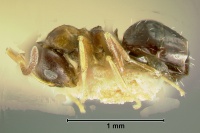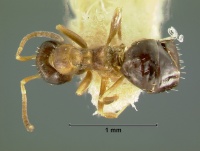Lepisiota aurea punctaticeps
| Lepisiota aurea punctaticeps | |
|---|---|

| |
| Scientific classification | |
| Kingdom: | Animalia |
| Phylum: | Arthropoda |
| Class: | Insecta |
| Order: | Hymenoptera |
| Family: | Formicidae |
| Subfamily: | Formicinae |
| Tribe: | Plagiolepidini |
| Genus: | Lepisiota |
| Species: | L. aurea |
| Subspecies: | L. aurea punctaticeps |
| Trinomial name | |
| Lepisiota aurea punctaticeps (Wheeler, W.M., 1935) | |
Identification
Distribution
Distribution based on Regional Taxon Lists
Indo-Australian Region: Philippines (type locality).
Distribution based on AntMaps
Distribution based on AntWeb specimens
Check data from AntWeb
Countries Occupied
| Number of countries occupied by this species based on AntWiki Regional Taxon Lists. In general, fewer countries occupied indicates a narrower range, while more countries indicates a more widespread species. |

|
Estimated Abundance
| Relative abundance based on number of AntMaps records per species (this species within the purple bar). Fewer records (to the left) indicates a less abundant/encountered species while more records (to the right) indicates more abundant/encountered species. |

|
Biology
Castes
Nomenclature
The following information is derived from Barry Bolton's Online Catalogue of the Ants of the World.
- punctaticeps. Acantholepis aurea subsp. punctaticeps Wheeler, W.M. 1935b: 46 (w.) PHILIPPINES. Combination in Lepisiota: Bolton, 1995b: 228.
Unless otherwise noted the text for the remainder of this section is reported from the publication that includes the original description.
Description
Worker
Length 2 mm.
Head subtrapezoidal, slightly longer than broad, distinctly narrowed anteriorly, with feebly convex sides and posterior border and rounded posterior corners. Eyes at the middle of the sides of the head, moderately convex, as long as their distance from its anterior corners. Mandibles convex, with 5 sub equal teeth. Clypeus convex, carinate, with broadly rounded, projecting anterior border. Frontal area obsolescent; frontal groove distinct anteriorly. Antennal scapes extending about one-fourth their length beyond the posterior border of the head. Pronotum with rounded humeri and convex sides and dorsal surface, decidedly broader than long; mesonotum transversely subelliptical, one and one-third times as broad as long; metanotum about two-thirds as broad as the pronotum, with prominent, dorsally projecting spiracles; the mesometanotal impression short but pronounced; epinotum somewhat narrower than the pronotum, subrectangular, the base on each side with a pair of stout longitudinal projections which terminate posteriorly in very blunt teeth bearing the epinotal spiracles at their tips. Petiolar scale thin, its summit acute and almost semi circularly excised, so that its corners from two blunt, flattened teeth which are about twice as long as broad at their bases, its sides and anterior surface somewhat convex. There is no peduncle-like prolongation behind the node.
Mandibles and clypeus shining, feebly and microscopically reticulate, the former with a few coarse piligerous punctures, remainder of head opaque, densely and finely punctate; thorax, petiole and appendages subopaque, sculptured like the head but more superficially; meso- and metaplurae longitudinally rugulose; gaster smooth and shining.
Hairs white, sparse, erect and obtuse, present only on the body; scapes and legs with fine, appressed, pale pubescence.
Head and thorax dark reddish brown; gula, occiput and epinotum darker and more blackish; mandibles, scapes, mesonotum, trochanters, tips of femora and tips and bases of tibire yellowish brown; funiculi fuscous; tarsi yellow, with the last joint brown; gaster black.
Type Material
Two specimens taken by Dr. J. W. Chapman, one at Baguio, Luzon Island (type locality) and one Dumaguete, Negros Oriental, Phillip pines.
References
- Bolton, B. 1995b. A new general catalogue of the ants of the world. Cambridge, Mass.: Harvard University Press, 504 pp. (page 228, Combination in Lepisiota)
- Wheeler, W. M. 1935b. New ants from the Philippines. Psyche (Camb.) 42: 38-52.(page 46, worker described)

